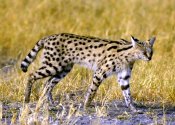
Worksheets and No Prep Teaching Resources
Reading Comprehension Worksheets
Animal Themes
Grasslands

Animal Themes
 Worksheets and No Prep Teaching Resources Reading Comprehension Worksheets Animal Themes Grasslands |
 Animal Themes |
| edHelper's suggested reading level: | grades 6 to 8 | |
| Flesch-Kincaid grade level: | 6.38 |
|
Servals
By Vickie Chao |

|
 1 Out on the grasslands of Africa, superb hunters are never in short supply. If we are to name a few, most people will call out lions, tigers, cheetahs, and leopards. Those four animals, as it turns out, all belong to the same family -- Felidae. The Felidae or cat family consists of about 40 members. Apart from the famous "fantastic four," there is actually another cat species in Africa whose killer instinct is just as good, if not better. That animal is called the serval. It can be found in various parts of Africa, south of the Sahara Desert. It prefers grassy areas with easy access to water.
1 Out on the grasslands of Africa, superb hunters are never in short supply. If we are to name a few, most people will call out lions, tigers, cheetahs, and leopards. Those four animals, as it turns out, all belong to the same family -- Felidae. The Felidae or cat family consists of about 40 members. Apart from the famous "fantastic four," there is actually another cat species in Africa whose killer instinct is just as good, if not better. That animal is called the serval. It can be found in various parts of Africa, south of the Sahara Desert. It prefers grassy areas with easy access to water. |
Create Weekly Reading Books
Prepare for an entire week at once! |
| Leave your feedback on Servals (use this link if you found an error in the story) |
 |
Animal Themes
|
 |
Grasslands
|
|
|